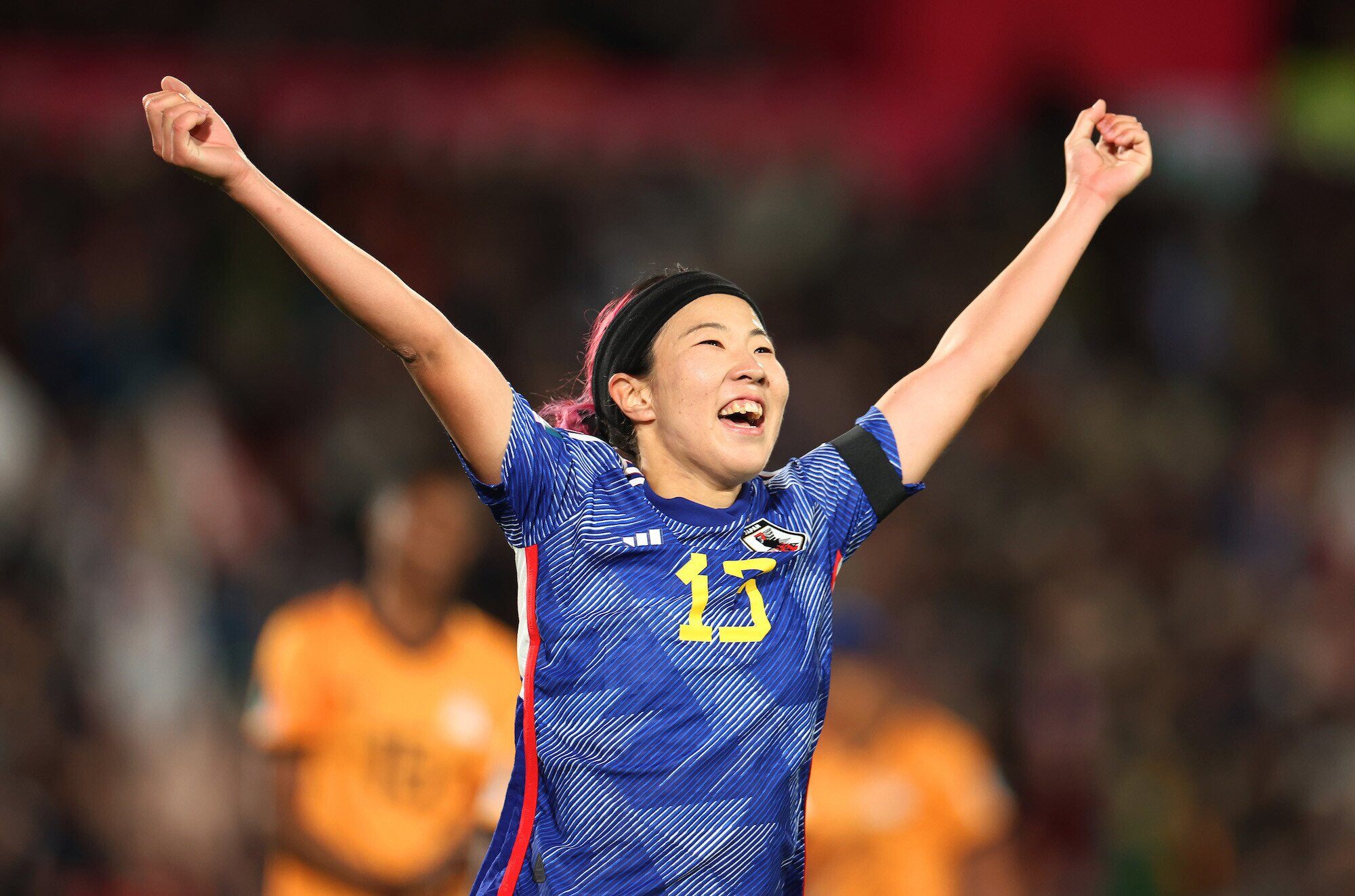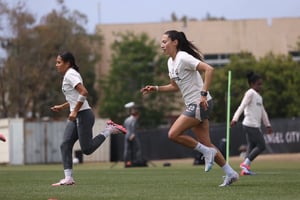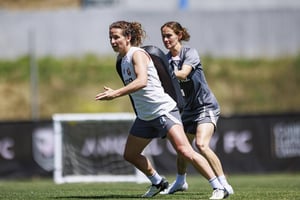Jun Endo Never Quits

The moment Jun Endo made contact with her opponent’s leg, she knew she’d injured her MCL.
Her next thought was the World Cup. With the tournament kicking off in just under two months, she had only five weeks to recover if she wanted to join the Nadeshiko’s training camp at the beginning of July.
“I’ve had that same injury before, so right away I could feel it,” she says through interpreter Saki Watanabe.
Upon her return to LA from the team’s 1–4 loss to OL Reign, an MRI confirmed what Endo already suspected: she’d sustained a sprain to her medial collateral ligament, or MCL, the soft tissue that connects the femur to the tibia on the inside of the knee.
“A sprain is the tearing of a tendon or a ligament,” explains Dr. Natasha Trentacosta, an orthopedic surgeon at Cedars-Sinai, Angel City’s official health partner. Trentacosta specializes in sports medicine, with training in both adult and pediatric patients.
“There are different degrees of tears,” she continues. “Smaller tears are considered a grade one, and a complete rupture, meaning there's a disconnect of that ligament or tendon, is a grade three.”
Endo’s injury was somewhere in the middle of the scale, which meant she wouldn’t need surgery, but would face a nontrivial recovery process—and with her departure date for national team camp looming, time was of the essence. Basically, she couldn’t afford any setbacks in her recovery.
“Because of my previous injuries, I know how long it can take to recover,” says Endo. “If it hadn’t been for the World Cup, I wouldn’t have been in such a hurry, but I definitely panicked a little bit.”
“That’s a very tight timeline for the severity of her injury,” says Trentacosta. A recreational or scholastic athlete with the same injury, she explained, would have likely progressed slower, but with a roster spot at the most important tournament in the sport on the line, Endo had to do everything she could to speed up her recovery.
Essentially, Endo’s treatment consisted of three things: bracing to stabilize the knee, in the early stages; platelet-rich plasma (PRP) injections; and physical therapy.
With PRP, explains Trentacosta, “the idea is that ligaments don't tend to be very vascular. They don't have a robust blood supply.”
“You need blood to heal and scar an area when it’s damaged,” she continues. “Whether it's muscles, ligaments, or even skin, blood brings clotting and scarring products to that area to help it heal. So with PRP, we're able to deliver directly, under ultrasound guidance, the material to help accelerate healing.”
The training staff, including Head Athletic Trainer Manny De Alba, got high-level guidance for Endo’s physical therapy from her doctors, and also kept the medical staff of the Japanese national team in the loop about her recovery timeline.

Symiah Campbell, the Angel City physical therapist who worked with Endo, explains that the end goal when rehabbing a knee injury is building joint stability. “Joints work two ways,” she says. “There’s passive stability, which is compromised with a ligament injury, and active stability, which has more to do with the muscles.”
When an athlete sustains this kind of injury, “there's a phase where there’s swelling and pain and those things kind of trigger your muscles to shut off,” Campbell continues. “So in the early stages, we worked a lot on getting her quad to fire again.”
“Physically I obviously relied a lot on the training staff,” says Endo. “I got icing and massage from them, and they also gave me a ‘menu’ of different exercises to do on my own. It was a rollercoaster mentally, but I trusted them.”
As important as ACFC’s medical team was, ultimately recovering from injury, especially on a quick timeline, requires active participation from the athlete. “There is a large personal responsibility on the injured athlete,” says Trentacosta. “As a professional player, [Endo] obviously has a very high level of drive, and being so disciplined actually helps a lot in terms of recovery.”
“Jun is extremely professional,” says Campbell. “She's kind of an ideal athlete to work with. There were days where things were tough in terms of how her knee felt physically or how she was feeling mentally, but she never quit and she always gave 100%. I think that’s really a big testament to who she is as a person.”
As her recovery progressed, Endo moved from basic movement—literally re-learning how to walk with correct mechanics—to strength exercises like squats and lunges, to plyometrics and finally on-field work.
Ultimately, the hardest moment for Endo was the day of the injury itself. “The medical staff told me from the beginning that I had time to recover,” she says. From there, it was just a matter of controlling what she could control and trusting the process.
“A lot of people supported me mentally and emotionally during my recovery,” says Endo. “I leaned a lot on my family in Japan—we talked all the time. My partner was very supportive, and so was the training staff [at Angel City].”
Despite all the reassurances that she’d be back in time, “I broke down when I learned I’d made the World Cup roster,” Endo says. “I was so relieved and happy.”
If you’re an Angel City fan, you likely already know that when Endo finally arrived in New Zealand with her Japan teammates, she crushed it. Both to the eye and statistically, Japan were the top team at the tournament into the Round of 16. They scored 11 goals in the group stage—the most of any team in the opening phase, and three more than the eventual champions, Spain—and conceded just three in the whole tournament. You’d never have known that Endo, who recorded a goal and two assists, had been on crutches just a month and a half prior.
Although the team’s elimination in the quarterfinal was disappointing, Endo says that compared with her first trip to the tournament in 2019, when her main emotion was nervousness, she was able to enjoy herself a lot more this time around.
She also says that this recovery process was a learning experience, as difficult as it was at times.
“The biggest thing I learned about was the importance of mentality,” she says. “It’s ok to not feel ok sometimes. You can’t control how you feel, but you can control how you treat yourself.”
.png?width=75&height=114&name=ACFC_Crest_Primary_Sol%20Rosa%20(1).png)

